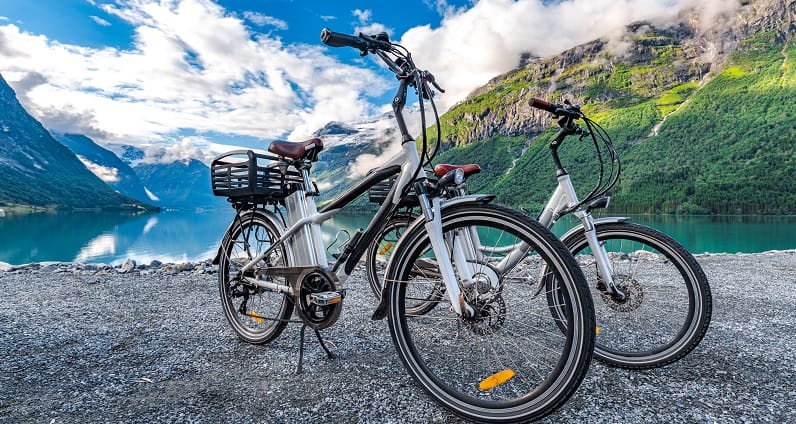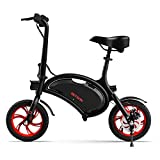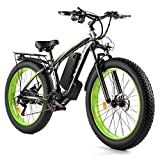Ever since the invention of bikes, they’ve stayed about the same. A traditional bicycle (two wheels, a handlebar for steering, and a pair of pedals to push) has been a staple of transportation for over a century. It’s the ideal device for getting to other places: it’s lightweight, easy to carry, and easy to make and produce. With such a simple human-powered machine, it was hard to make the thing any better.
Until now. With an integrated battery, a mid drive motor or hub motor, and widespread availability at your local bike shop, the electric bike has taken the market like a storm. This simple yet brilliant device has improved on the classic bicycle in a significant, modern way. For years, bicycles have only been as fast and as powerful as their riders. Now that’s all changed. The rear tire isn’t just human-powered anymore; with the addition of an extra battery to a traditional bike, the rear wheel can tackle tough terrain, from a mountain trail to a steep uphill slope.
Part rider-powered, part machine-powered, electric bikes take the burden off their human riders and leave power to the machine. An ebike’s electrical components produce extra torque, allowing for a little extra help while riding. They have multiple speeds, and the pedal assist is seamless. Instead of making it up that hill by yourself, how about some help from a material that doesn’t get tired and worn out? Switch the pedal assist on and off at will at the click of a button. With the ability to tackle rocky roads and tricky turns, the addition of an electric motor turns good bikes into great bikes. Every mile becomes easier when you power up your regular bike with electric capabilities.
On top of that, bikes all need a little extra support every now and then. The mechanical additions that an ebike brings to the field are phenomenal. Any bike shop is incomplete without an ebike to show off to beginners and bicycle enthusiasts alike. Going on a camping trip with friends? Take your electric mountain bike along and hit the slopes! With machines to help pull the bike’s load, you can spend less time fatigued and more time doing what you love best: hitting an intense bike path with everything you’ve got.
But these amazing bikes aren’t reserved for uncharted roads; on the contrary, they’re applicable just about anywhere there’s a path or trail. An electric bike turns any ride into an easier one, with a battery that keeps working even when you get tired. Turn up the throttle and turn down the worry! Your bike battery can handle this ride. As you pedal, the bike matches your strength and helps your rear wheel keep moving. This innovation allows for better steering, since your mind won’t be on pedaling as much. Arrive at your office or home with greater ease than ever before. Electric bikes are giving out amazing rides. For anyone who’s ever considered getting a bicycle, the time is now.
Table Of Contents
Bestselling Electric Bikes in 2021
- Take charge: Rechargeable lithium-ion battery
- EASY TO ASSEMBLE AND OF HIGH QUALITY-- KBJPADS adult bikes has been pre-installed 92%, made of light and strong aluminum alloy frame, light and strong, longer service life, better shock absorption effect, and it will bring you the best Riding experience. It is equipped with LED headlights, aluminum aluminum suspension fork, Lockable shock absorber front fork and Front and rear mechanical disc brake.
What is an electric bike?
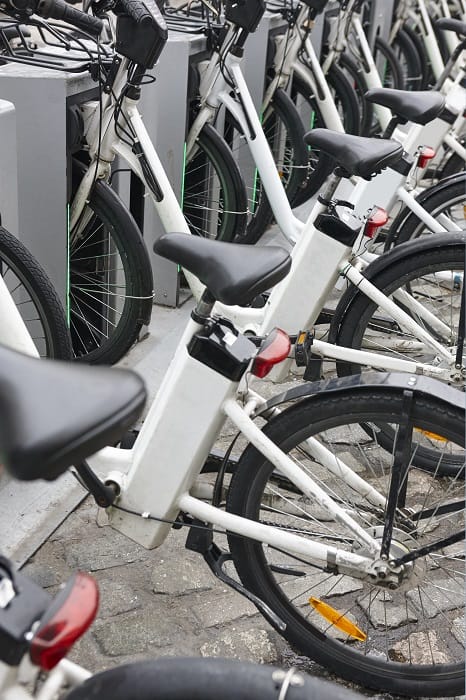
As you might have guessed from the name, an electric bike (or ebike, sometimes spelled “e bike”) is a regular bike with a battery motor attached. The motor runs power to the rear wheel and bike pedals, and that power is connected to a throttle or control in the handlebar. Depending on what type of ride you feel like that day, the ebike acts as a copilot or extra driver.
Because the pedals are directly connected to an electric mechanism, the motor can push along the bike with extra power. An ordinary bicycle runs on just your power, going as fast as whatever you’re pedaling. Although biking is an excellent exercise method, this motion can quickly lead to soreness and fatigue, especially on long rides on difficult paths. What if you’re late to work, or you’re exhausted after a long day of physical labor.
Sometimes it’s good to get extra exercise in, but you can also open yourself up to other options. Ebikes are an amazing option because of how well they conserve your energy. They allow you to do more things on the road because you aren’t expending all your strength pedaling. It can be nice to let the road go by and relax a little as the breeze blows through your hair.
And if you’re using a bicycle for recreation, using an electric bike kit can enhance your regular bike into an ebike. Slopes and steep hills that would otherwise take the wind out of you can feel like you’re soaring. Go farther along trails than your limited energy would otherwise allow. Discover new sites and explore new parks, trails, and areas by going farther with the ebike’s strength. The battery motor optimizes your ride with extra speed and power. A journey that might feel like a strenuous trek becomes much easier and much more enjoyable.
(They even have electric scooters! If bikes aren’t your thing, or if you’re looking to experiment with something different from a bicycle, an electric scooter might be a great option for a secondary machine. There are good bikes and scooters available with electric motors from high-end bike companies. Find whatever ride works for you and stick with it.)
Is it hard to pedal an electric bike?
Not at all! On the contrary, the electric bicycle makes it easier to pedal. The motor attached to your bike allows the pedals to rotate with less force, which means you don’t have to strain yourself as much to make it up that hill.
Think of an ebike’s motor like power steering in a car. This special fluid lubricates the system and allows the wheel to turn more efficiently. That means you don’t have to expend as much strength cranking the wheel like cars required you to do in the old days. Without power steering, you’d still be able to move the steering wheel, but that wheel would feel a lot less inclined to respond to your directions. You’d have to pull and twist and coax that wheel into the right position for every small adjustment. You’d get tired pretty quickly!
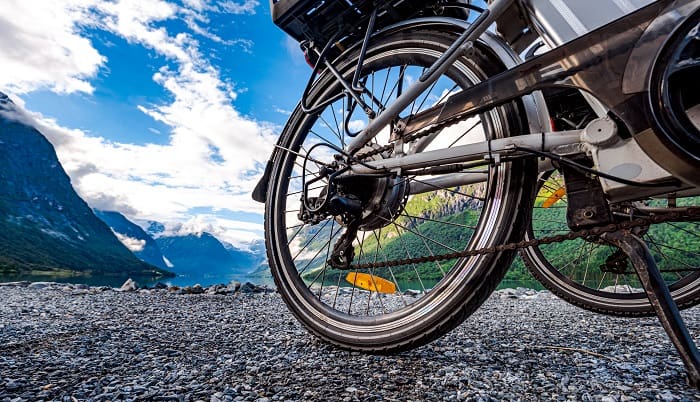
Now imagine a bicycle with similar optimization, only this time for its pedaling abilities. You never knew you were riding a bike without “power steering” your whole life, did you? The ability to put extra power into a bike’s performance means you don’t have to pedal as hard. The machine shares the load by spinning the rear wheel as you pedal.
In fact, some electric bikes can charge their battery while you pedal. This enhancement allows for kinetic energy from spinning the wheel to convert to electricity, which is stored back in your bicycle’s motor. The motor then uses this energy to keep turning the pedals, which in turn keeps helping you along your bike ride. It’s not perfectly efficient, of course. A lot of energy is lost between the pedaling and the moto. But all the same, it allows the battery to keep chugging away, and you get a smoother, safer ride than if you didn’t have an ebike motor at all.
Are electric bikes good for hills?
Yes, very much so! In fact, hills may have been the reason why ebikes were invented in the first place! Hills and rough ridges are the places that riders need a little extra push. Terrain like this can be difficult to overcome and can leave you feeling exhausted before you even reach your destination.
That’s why ebikes are so useful on uphill climbs. Because the motor is helping to drive the pedals, you won’t have to pedal as hard on slopes, which leaves you with more energy to climb. It also takes your mind off of pedaling and back onto the road, meaning that you can steer and direct yourself to your destination. Like a traditional bicycle, ebikes are still susceptible to hitting dips and potholes. But unlike a non-ebike, a bicycle powered with an electric conversion kit saves you more brain power (and muscle power) to look where you’re going.
With multiple speeds on the throttle, the ebike can take as much of the climb as you like. (Please keep in mind that running at high speed/high gear for long periods of time will deplete the battery’s storage power quicker than regular speeds.) When there’s a tough hill to climb, simply turn up the power and feel the machine help out. Changing settings on the electric throttle is made to be exactly like changing gears/speeds on a standard bike. When you’re going uphill, most bikers will set the gear to something more optimal for the slope.
Cars have this option, as well, with lower/higher gears depending on whatever the driver requires. In this sense, ebikes are more like automatic cars, with the ability to easily tackle such climbs. Once you’ve hit a downhill descent again, turn the power down and allow yourself to take more control over pedaling. That way, you can control how much you want to control the bike.
If you’re looking for a challenge that day, take your ebike without using its power and give yourself room to exercise those leg muscles. But for everyday treks and difficult paths, you now have a great way to use your energy more wisely by conserving it for longer, faster rides. Although the battery may run out of power eventually, the machine itself doesn’t get tired and it rarely needs a break. Use this fact to your advantage by allowing the motor to do the work when you need a little break.
In addition to regular bicycles, there are ebikes made for other types of terrain. For example, e-MTBs (electric mountain bikes) are great for hills and untamed terrain. They can tackle tons of roads and rocky ascents that regular bikes might struggle with. Ebikes are so good for hills that the e-MTB was made to optimize the electric bicycle’s abilities on steep slopes! For even more information about e-MTBs, check out our other article here.
What are the three classes of ebikes?
Because an ebike is technically categorized as a motor vehicle, its speed is limited to three separate classes. Any faster than these categories and an ebike becomes a moped or motorcycle. The three classes of ebikes are simply referred to Class 1, 2, and 3, and they are as follows:
Class 1: 20 mph assisted speed limit without a throttle.
Class 2: 20 mph assisted speed limit with a throttle.
Class 3: 28 mph assisted speed limit with a throttle.
All three of these ebike classes have pedal assist in some capacity, but how fast they’re allowed to go depends on the manufacturer’s preferences. Some people prefer a Class 1 over a Class 2, as they don’t want an automatic throttle to accompany their bicycle. Not to mention, anything faster than 28 mph starts getting pretty speedy, and it’s hard for humans to keep up with that speed (even with pedal assist). For more information about ebike motors and speeds, feel free to follow our other article on electric mountain bikes.
How fast does an ebike go?
That depends on the class of motor accompanying it. There are two main reasons for this system of classification. First, manufacturers want to optimize the things they create; that way, they know they’re following the same pattern and quality standards for everything they sell. And secondly, governments need to regulate anything that comes through their borders so there are strict classifications on what ebikes can do.
That’s how we got the three-Class system. It’s an easy way to keep track of exactly how fast the ebike can go, and quickly tells potential buyers about the machine’s potential. If, for example, you want to make sure your ebike has a throttle attached, be sure to ask for a Class 2 or 3 motor. Otherwise, you might find yourself with a Class 1, which has the same top speed as a 2 but without a throttle.
Do electric bikes have a throttle?
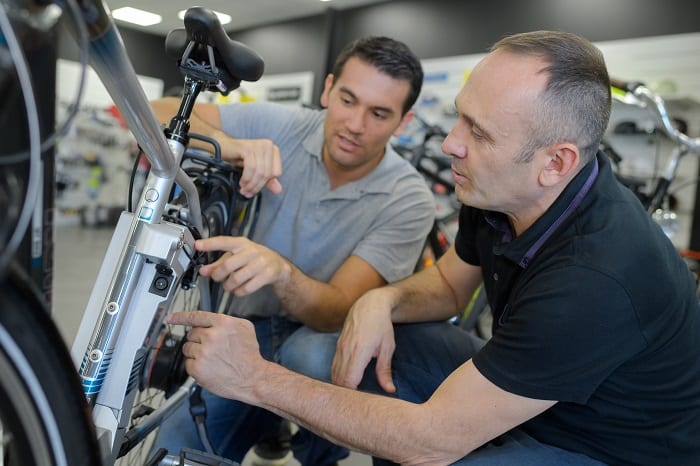
Yes, though that depends on the classification. The motor is really the key to whether or not you’ll have a throttle on your ebike. If, for example, your motor is a weaker one intended for paved roads and comfortable city cement, you probably won’t need to be gunning at 80 mph down untamed wilderness to escape wild animals. To keep up with what each job needs, manufacturers have allowed for throttles to match whatever motor specifications the product environment demands. Not to mention, there’s only so much an ebike throttle can do. Without a human who knows how to ride a bike, the machine can’t even leave the garage. It’s a pedal assist device, not an autopilot. You still need to take it for a test ride and make sure all the gears and gizmos are operational before committing to a purchase.
In addition, the throttle is kept at low speeds for optimized use by humans. There isn’t much you can do to speed up a bike beyond its physical parameters. While experienced cyclists can travel quite quickly, there is a speed barrier at which the pedals spin so fast that the bike goes out of control. Perhaps you’ve experienced this while going down a hill. The pedals keep turning as the wheels picks up sudden momentum, especially if the bike is at a slower speed. In much the same way, throttles have to account for what is physically possible for humans.
After speeds faster than 20 or 28 mph, it’s hard to keep the pedal assist optimized and under the human rider’s control. That’s why the system caps out at that number. At that point, the machine is doing so much of the work that it’s slower to integrate its efforts with a human counterpart, so you might as well make a vehicle that works by itself. Mopeds and motorcycles are still great ways to get around town, but they are often more expensive than regular ebikes. They also don’t deliver the same amount of exercise, since you’re just sitting or standing through the whole ride. Even though ebikes allow you to switch to electric pedaling power, you still get a cardio workout from the experience.
What should I know before buying an electric bike?
First, you should look into the options for buying an ebike. The market has become popular enough that several manufacturers are willing to invest in their production. This variety is mostly a good thing, as there are many models to choose from. But it also means you’ll have to do careful research to find out which electric bicycle is best for you.
Read the product description carefully and compare prices with other models. Expect electric bikes to be a little more expensive than traditional bikes. The biggest reason for this is that electric bikes have motors and electric parts attached. The motor alone can account for much of the price, as it’s the most important piece of machinery.
These differences come to an important point: knowing your own route. Figure out where you’ll be using the ebike. Where possible, ride the path beforehand and get a feel for the terrain. Ask yourself whether you’d prefer a lot of pedal assistance or only a little; depending on the road, you may want to look for a Class 2 instead of a Class 1. You can also figure out how often you’ll be using the bike. If you’re going to use the bike regularly, your route will require higher-end construction, which could call for a bigger investment.
Regardless of which type of bike you choose, you’ll need a firm understanding of where, when, and how often you’ll ride the ebike. Take this time to also purchase the necessary safety equipment. Check up on the local laws in your region to find out what your bike will need before hitting the road. Look into installing devices like wheel reflectors, handlebar lights, and bells before committing to any rides. Bike safety equipment becomes especially important in urban areas where you’ll be driving at night. And ensure that all the parts and materials of the ebike you’re purchasing all work together. It can be hard to hunt down individual parts after discovering that something is missing.
What’s an electric bike kit?
One thing to lower the price would be to install the electronics yourself. This process may sound complicated, but it can be quite simple. There’s an entire market for DIY electric bikes, which allows you to install electrical components onto an ordinary bike.
An electric bike kit, also known as an ebike conversion kit, is a set of parts allowing you to install a bike motor onto a bike. The kit comes with a motor comparable to one installed on a regular ebike. It also comes with the proper materials, setup, and instruction manual to help you on your way.
Ebike conversion kits have two major advantages over standard ebikes. First, they’re a little bit cheaper. While a high-end bicycle already costs a lot anyway, electric bikes bump that price up even more. There are many reasons for this price increase, including extra manufacturing, electrical work, remaking parts specifically for the electronic components, and the fact that it’s a novelty. But conversion kits install a basic motor onto the rear wheel and help it turn with the pedals. Bikes installed with an ebike kit output similar performance to manufactured ebikes, but at a much lower cost.
And that brings us to the second advantage of electric bike kits: you get to keep your old bike. You may already have a ride you love, one you don’t want to give up for a new product. But you can still enjoy the benefits of pedal assist while using whatever bike you have. For example, if your mountain bike has served you well, and you’re curious whether installing a rear wheel motor would help its performance, go ahead and try it out on your old bike!
If you decide to buy an ebike kit, make sure it has all its parts and that it’s compatible with your current bicycle. Keep in mind that different motor types have similar advantages and disadvantages when transferred over to ebike kits. Mid drive kits have more power, and are better for rough roads. But they’re also more expensive and much more complicated to install. On the other hand, hub motors can pop into the rear wheel quite easily and are more reliable for quick fixes. Be familiar with how you’re going to use your bike. A mid drive is a must for the outdoorsy types, and hub motors are reliable for commutes.
We recently put together a whole article about electric bike kits and the advantages they bring to the table. Check it out here.
What is a folding ebike?
It’s an awesome type of ebike that folds down when you’re not using it. A foldable ebike collapses to a smaller size, and is easy to carry around after your ride. If there’s not a convenient bike rack next to your work, take a duffle bag and carry the folding ebike in with you. It still has pedal assist capabilities and still puts in extra power for every twist and turn on the road, but it’s extremely portable and convenient when not in use.
One disadvantage of a foldable ebike is that it is built for well-maintained city roads. There’s only so much you can fit in a duffle bag, after all, and folding ebikes are optimized for convenient rides. But if you take good care of it, you can be sure to enjoy an easier commute for years to come.
Conclusion
Ebikes are taking the transportation world by storm, and it’s time to catch the wave. You don’t need tons of cycling experience to enjoy ebike benefits. All you need to start is a little planning and preparation, as well as some route knowledge.
Whether you invest in a hub motor or mid drive motor is up to you, but either one will do just fine for your needs. The motors’ pedal assist abilities mean you can conserve your strength to tackle big climbs and tricky turns. An ebike’s flexibility allows you to enjoy taking a ride to work, through the park, or through mountains and wildlands. Not to mention the exercise benefits, which help you to stay healthy and happy by getting outdoors and working your leg muscles. Let the machine do the work and put the relaxation back into biking. The “e” in ebike stands for “easy.”

